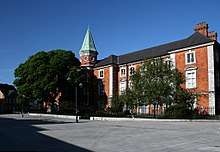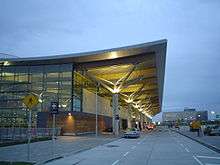Cork (city)
Cork (/kɔːrk/; Irish: Corcaigh, pronounced [ˈkoɾkɪɟ], from corcach, meaning "marsh")[6] is the second largest city in Ireland, located in the south-west of Ireland, in the province of Munster. Following an extension to the city's boundary in 2019, its population is c. 210,000.[3]
Cork Corcaigh | |
|---|---|
City | |
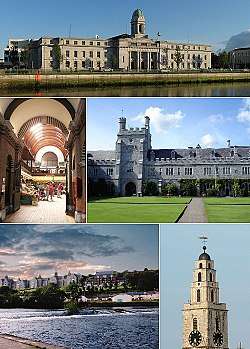 From top, left to right: City Hall, the English Market, Quadrangle in UCC, the River Lee, Shandon Steeple | |
_coat_of_arms.svg.png) Coat of arms | |
| Nicknames: The Rebel City, Leeside, The Real Capital | |
| Motto(s): | |
 Cork City | |
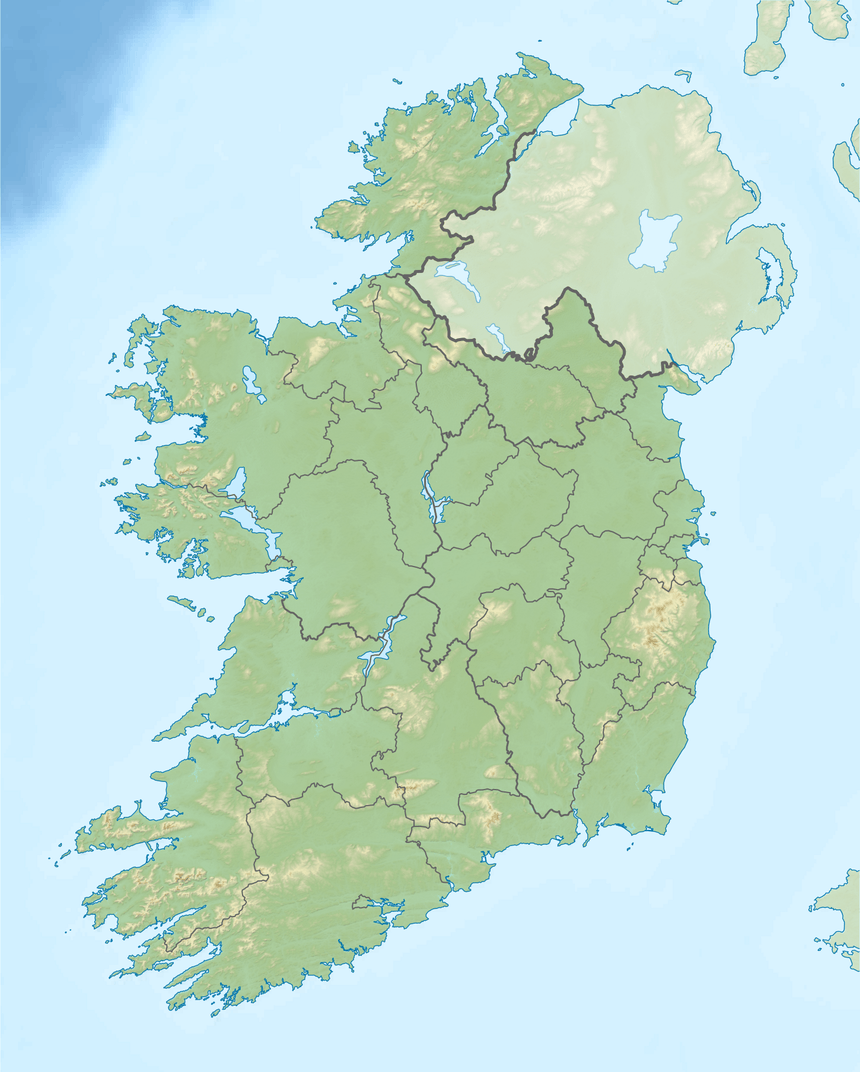 Cork Cork City  Cork Cork (Europe) | |
| Coordinates: 51°53′50″N 8°28′12″W | |
| State | Ireland |
| Province | Munster |
| County | Cork |
| Founded | 6th century AD |
| City rights | 1185 AD |
| Government | |
| • Type | Cork City Council |
| • Lord Mayor | Joe Kavanagh |
| • LEAs | 5 |
| • Dáil Éireann | |
| • European Parliament | South |
| Area | |
| • City | 187 km2 (72 sq mi) |
| • Urban | 174 km2 (67 sq mi) |
| • Metro | 820 km2 (320 sq mi) |
| Population | |
| • Estimate (2019) | 210,000[3] |
| • Density | 1,123/km2 (2,910/sq mi) |
| • Urban | 208,669[4] |
| • Metro | 305,222[5] |
| • Demonym | Corkonian, Leesider |
| Time zone | UTC0 (WET) |
| • Summer (DST) | UTC+1 (IST) |
| Eircode | T12, T21 and T23 |
| Area code(s) | 021 |
| Vehicle index mark code | C |
| Website | www.corkcity.ie |
The city centre is an island positioned between two channels of the River Lee which meet downstream at the eastern end of the city centre, where the quays and docks along the river lead outwards towards Lough Mahon and Cork Harbour, one of the largest natural harbours in the world.[7][8]
Originally a monastic settlement, Cork was expanded by viking invaders around 915. Its charter was granted by Prince John in 1185. Cork city was once fully walled, and the remnants of the old medieval town centre can be found around South and North Main streets. The third largest city by population on the island of Ireland, the city's cognomen of "the rebel city" originates in its support for the Yorkist cause in the Wars of the Roses.[9] Corkonians sometimes refer to the city as "the real capital",[10] a reference to its opposition to the Anglo-Irish Treaty in the Irish Civil War.[11]
History
Cork was originally a monastic settlement, reputedly founded by Saint Finbarr in the 6th century.[12] Cork became (more) urbanised some point between 915 and 922 when Norseman (Viking) settlers founded a trading port.[13] It has been proposed that, like Dublin, Cork was an important trading centre in the global Scandinavian trade network.[14] The ecclesiastical settlement continued alongside the Viking longphort, with the two developing a type of symbiotic relationship; the Norsemen providing otherwise unobtainable trade goods for the monastery, and perhaps also military aid.[15]
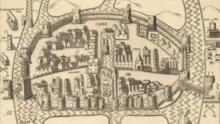
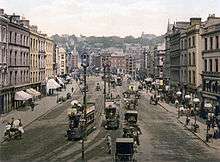
The city's charter was granted by Prince John, as Lord of Ireland, in 1185.[16] The city was once fully walled, and some wall sections and gates remain today.[17] For much of the Middle Ages, Cork city was an outpost of Old English culture in the midst of a predominantly hostile Gaelic countryside and cut off from the English government in the Pale around Dublin. Neighbouring Gaelic and Hiberno-Norman lords extorted "Black Rent" from the citizens to keep them from attacking the city. The present extent of the city has exceeded the medieval boundaries of the Barony of Cork City; it now takes in much of the neighbouring Barony of Cork. Together, these baronies are located between the Barony of Barrymore to the east, Muskerry East to the west and Kerrycurrihy to the south.
.jpg)
The city's municipal government was dominated by about 12–15 merchant families, whose wealth came from overseas trade with continental Europe – in particular the export of wool and hides and the import of salt, iron and wine.
The medieval population of Cork was about 2,100 people. It suffered a severe blow in 1349 when almost half the townspeople died of plague when the Black Death arrived in the town. In 1491, Cork played a part in the English Wars of the Roses when Perkin Warbeck a pretender to the English throne, landed in the city and tried to recruit support for a plot to overthrow Henry VII of England. The then mayor of Cork and several important citizens went with Warbeck to England but when the rebellion collapsed they were all captured and executed.
The title of Mayor of Cork was established by royal charter in 1318, and the title was changed to Lord Mayor in 1900 following the knighthood of the incumbent mayor by Queen Victoria on her visit to the city.[18]
Since the nineteenth century, Cork had been a strongly Irish nationalist city, with widespread support for Irish Home Rule and the Irish Parliamentary Party, but from 1910 stood firmly behind William O'Brien's dissident All-for-Ireland Party. O'Brien published a third local newspaper, the Cork Free Press. Cork was overtaken by Belfast as Ireland's second largest city in the nineteenth-century.
In the War of Independence, the centre of Cork was burnt down by the British Black and Tans,[19] in an event known as the "Burning of Cork"[19] and saw fierce fighting between Irish guerrillas and UK forces. During the Irish Civil War, Cork was for a time held by anti-Treaty forces, until it was retaken by the pro-Treaty National Army in an attack from the sea.
Climate
The climate of Cork, like the vast majority of Ireland, is mild oceanic (Cfb in the Koeppen climate classification) and changeable with abundant rainfall and a lack of temperature extremes. Cork lies in plant Hardiness zone 9b. Met Éireann maintains a climatological weather station at Cork Airport,[20] a few kilometres south of the city centre. The airport is at an altitude of 151 metres (495 ft) and temperatures can often differ by a few degrees between the airport and the rest of the city. There are also smaller synoptic weather stations at UCC and Clover Hill.[20] Due to its position on the coast, Cork city is subject to occasional flooding.[21]
Temperatures below 0 °C (32 °F) or above 25 °C (77 °F) are rare. Cork Airport records an average of 1,227.9 millimetres (48.34 in) of precipitation annually, most of which is rain.[22] The airport records an average of 7 days of hail and 11 days of snow or sleet a year; though it only records lying snow for 2 days of the year. The low altitude of the city, and moderating influences of the harbour, mean that lying snow very rarely occurs in the city itself. There are on average 204 "rainy" days a year (over 0.2 millimetres (0.0079 in) of rainfall), of which there are 73 days with "heavy rain" (over 5 millimetres (0.20 in)).[22] Cork is also a generally foggy city, with an average of 97 days of fog a year, most common during mornings and during winter. Despite this, however, Cork is also one of Ireland's sunniest cities, with an average of 3.9 hours of sunshine every day and only having 67 days where there is no "recordable sunshine", mostly during and around winter.[22]
| Climate data for Cork (ORK), 1981–2010 normals, extremes 1961–present | |||||||||||||
|---|---|---|---|---|---|---|---|---|---|---|---|---|---|
| Month | Jan | Feb | Mar | Apr | May | Jun | Jul | Aug | Sep | Oct | Nov | Dec | Year |
| Record high °C (°F) | 16.1 (61.0) |
14.0 (57.2) |
15.7 (60.3) |
21.2 (70.2) |
23.6 (74.5) |
27.5 (81.5) |
28.7 (83.7) |
28.0 (82.4) |
24.7 (76.5) |
21.4 (70.5) |
16.2 (61.2) |
13.8 (56.8) |
28.7 (83.7) |
| Average high °C (°F) | 8.2 (46.8) |
8.3 (46.9) |
9.9 (49.8) |
11.8 (53.2) |
14.4 (57.9) |
17.0 (62.6) |
18.7 (65.7) |
18.5 (65.3) |
16.5 (61.7) |
13.2 (55.8) |
10.3 (50.5) |
8.5 (47.3) |
12.9 (55.2) |
| Daily mean °C (°F) | 5.6 (42.1) |
5.7 (42.3) |
6.9 (44.4) |
8.4 (47.1) |
10.9 (51.6) |
13.5 (56.3) |
15.3 (59.5) |
15.2 (59.4) |
13.3 (55.9) |
10.5 (50.9) |
7.8 (46.0) |
6.1 (43.0) |
9.9 (49.8) |
| Average low °C (°F) | 3.0 (37.4) |
3.1 (37.6) |
4.0 (39.2) |
4.9 (40.8) |
7.4 (45.3) |
10.0 (50.0) |
11.8 (53.2) |
11.8 (53.2) |
10.2 (50.4) |
7.7 (45.9) |
5.2 (41.4) |
3.7 (38.7) |
6.9 (44.4) |
| Record low °C (°F) | −8.5 (16.7) |
−8.6 (16.5) |
−6.1 (21.0) |
−2.4 (27.7) |
−0.9 (30.4) |
2.4 (36.3) |
4.8 (40.6) |
4.9 (40.8) |
2.3 (36.1) |
−0.9 (30.4) |
−3.3 (26.1) |
−7.2 (19.0) |
−8.6 (16.5) |
| Average precipitation mm (inches) | 131.4 (5.17) |
97.8 (3.85) |
97.6 (3.84) |
76.5 (3.01) |
82.3 (3.24) |
80.9 (3.19) |
78.8 (3.10) |
96.8 (3.81) |
94.6 (3.72) |
138.2 (5.44) |
120.0 (4.72) |
133.1 (5.24) |
1,227.9 (48.34) |
| Average precipitation days (≥ 1.0 mm) | 16 | 13 | 14 | 11 | 12 | 10 | 10 | 11 | 11 | 15 | 14 | 15 | 152 |
| Average snowy days | 3.1 | 3.1 | 2.0 | 0.7 | 0.0 | 0.0 | 0.0 | 0.0 | 0.0 | 0.0 | 0.3 | 2.2 | 11.3 |
| Average relative humidity (%) (at 15:00 UTC) | 83.7 | 78.9 | 75.5 | 71.3 | 70.9 | 71.5 | 72.9 | 72.8 | 75.4 | 80.4 | 83.4 | 85.4 | 76.8 |
| Mean monthly sunshine hours | 55.8 | 67.8 | 102.3 | 159.0 | 192.2 | 174.0 | 167.4 | 161.2 | 129.0 | 93.0 | 69.0 | 57.2 | 1,427.9 |
| Mean daily sunshine hours | 1.8 | 2.4 | 3.3 | 5.3 | 6.2 | 5.8 | 5.4 | 5.2 | 4.3 | 3.0 | 2.3 | 1.7 | 3.9 |
| Source: Met Éireann[23][24][25] | |||||||||||||
Culture

The Cork School of Music and the Crawford College of Art and Design provide a throughput of new blood, as do the active theatre components of several courses at University College Cork (UCC). Important elements in the cultural life of the city are: Corcadorca Theatre Company, of which Cillian Murphy was a troupe member[26] prior to Hollywood fame; the Institute for Choreography and Dance, a national contemporary dance resource;[27] the Triskel Arts Centre (capacity c.90), which includes the Triskel Christchurch independent cinema; dance venue the Firkin Crane (capacity c.240); the Cork Academy of Dramatic Art (CADA) and Graffiti Theatre Company;[28] and the Cork Jazz Festival, Cork Film Festival[29] and Live at the Marquee events. The Everyman Palace Theatre (capacity c.650) and the Granary Theatre (capacity c.150) both host plays throughout the year.
Cork is home to the RTÉ Vanbrugh Quartet, and popular rock musicians and bands including John Spillane, Rory Gallagher, Five Go Down to the Sea?, Microdisney, The Frank and Walters, Sultans of Ping, Simple Kid, Fred and Mick Flannery. The opera singers Cara O'Sullivan, Mary Hegarty, Brendan Collins, and Sam McElroy are also Cork born.
Ranging in capacity from 50 to 1,000, the main music venues in the city are the Cork Opera House (capacity c.1000), The Everyman, Cyprus Avenue, Dali, Triskel Christchurch, The Roundy, and Coughlan's.[30]
The city's literary community centres on the Munster Literature Centre and the Triskel Arts Centre.[31] The short story writers Frank O'Connor and Seán Ó Faoláin hailed from Cork, and contemporary writers include Thomas McCarthy, Gerry Murphy, and novelist and poet William Wall.
Additions to the arts infrastructure include modern additions to the Crawford Municipal Art Gallery and renovations to the Cork Opera House in the early 21st century.[32] The Lewis Glucksman Gallery opened in the Autumn of 2004 at UCC, was nominated for the Stirling Prize in the United Kingdom, and the building of a new €60 million School of Music was completed in September 2007.
Cork was the European Capital of Culture for 2005, and in 2009 was included in the Lonely Planet's top 10 "Best in Travel 2010". The guide described Cork as being "at the top of its game: sophisticated, vibrant and diverse".[33]
There is a rivalry between Cork and Dublin, similar to the rivalry between Manchester and London, Melbourne and Sydney or Barcelona and Madrid. Some Corkonians view themselves as different from the rest of Ireland, and refer to themselves as "The Rebels"; the county is known as the Rebel County. This view sometimes manifests itself in humorous references to the Real Capital and the sale of T-shirts with light-hearted banners celebrating The People's Republic of Cork.[34]
Food
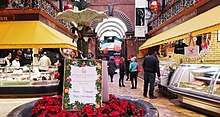
The city has many local traditions in food, including crubeens, tripe and drisheen, which were historically served in eating houses like that run by Katty Barry in the mid-20th century.[35] The English Market sells locally produced foods, including fresh fish, meats, fruit and vegetables, eggs and artisan cheeses and breads. During certain city festivals, food stalls are also sometimes erected on city streets such as St. Patrick's Street or Grand Parade.[36]
Accent
The Cork accent, part of the Southwest dialect of Hiberno-English, displays various features which set it apart from other accents in Ireland. Patterns of tone and intonation often rise and fall, with the overall tone tending to be more high-pitched than other Irish accents. English spoken in Cork has a number of dialect words that are peculiar to the city and environs. Like standard Hiberno-English, some of these words originate from the Irish language, but others through other languages Cork's inhabitants encountered at home and abroad.[37] The Cork accent displays varying degrees of rhoticity, usually indicative of the speaker's local community.
Media
Broadcasting

Broadcasting companies based in Cork include RTÉ Cork, which has a radio, television and production unit on Father Matthew Street in the city centre. Communicorp Media opened a radio studio in 2019 in the city covering content on both Today FM and Newstalk.[38] Virgin Media Television also has an office in the city which covers local news stories developing within the city and county.
The city's FM radio band features RTÉ Radio 1, RTÉ 2fm, RTÉ lyric fm, RTÉ Raidió na Gaeltachta, Today FM, Classic Hits, Newstalk and the religious station Spirit Radio. There are also local stations such as Cork's 96FM, Cork's Red FM, C103, CUH 102.0FM, UCC 98.3FM (formerly Cork Campus Radio 97.4fm)[39] and Christian radio station Life 93.1FM.[40] Cork also has a temporary licensed citywide community station 'Cork FM Community Radio' on 100.5FM, which is on-air on Saturdays and Sundays only. Cork has also been home to pirate radio stations, including South Coast Radio and ERI in the 1980s. Today some small pirates stations remain.
Print
Cork is home to one of Ireland's main national newspapers, the Irish Examiner (formerly the Cork Examiner). Its 'sister paper', The Echo (formerly the Evening Echo), was for decades connected to the "Echo boys", who were poor and often homeless children who sold the newspaper. Today, the shouts of the vendors selling the Echo can still be heard in parts of the city centre. One of the biggest free newspapers in the city is the Cork Independent.[41] The city's university publishes the UCC Express and Motley magazine.[42][43]
Places of interest

Cork features architecturally notable buildings originating from the Medieval to Modern periods.[44] The only notable remnant of the Medieval era is the Red Abbey. There are two cathedrals in the city; St. Mary's Cathedral and Saint Fin Barre's Cathedral. St Mary's Cathedral, often referred to as the North Cathedral, is the Catholic cathedral of the city and was begun in 1808. Its distinctive tower was added in the 1860s. St Fin Barre's Cathedral serves the Church of Ireland (Anglican) and is possibly the more famous of the two. It is built on the foundations of an earlier cathedral. Work began in 1862 and ended in 1879 under the direction of architect William Burges.
St. Patrick's Street, the main street of the city which was remodelled in the mid-2000s, is known for the architecture of the buildings along its pedestrian-friendly route and is the main shopping thoroughfare. At its northern end is a landmark statue of Father Mathew. The reason for its curved shape is that it was originally a channel of the River Lee which was built over on arches.[45] The General Post Office, with its limestone façade, is on Oliver Plunkett Street, on the site of the Theatre Royal which was built in 1760 and burned down in 1840. The English circus proprietor Pablo Fanque rebuilt an amphitheatre on the spot in 1850, which was subsequently transformed into a theatre and then into the present General Post Office in 1877.[46][47] The Grand Parade is a tree-lined avenue, home to offices, shops and financial institutions. The old financial centre is the South Mall, with several banks whose interior derive from the 19th century, such as the Allied Irish Bank's which was once an exchange.
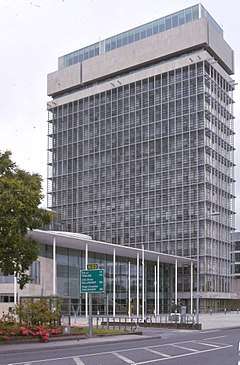
Many of the city's buildings are in the Georgian style, although there are a number of examples of modern landmark structures, such as County Hall tower, which was, at one time the tallest building in Ireland[48] until being superseded by another Cork City building: The Elysian. Outside the County Hall is the landmark sculpture of two men, known locally as 'Cha and Miah'. Across the river from County Hall is Ireland's longest building;[49] built in Victorian times, Our Lady's Psychiatric Hospital has now been partially renovated and converted into a residential housing complex called Atkins Hall, after its architect William Atkins.[50]
Cork's most famous building is the church tower of Shandon, which dominates the North side of the city. It is widely regarded as the symbol of the city. The North and East sides are faced in red sandstone, and the West and South sides are clad in the predominant stone of the region, white limestone. At the top sits a weather vane in the form of an eleven-foot salmon.[51] Another site in Shandon is Skiddy's Almshouse, which was built in the 18th century to provide a home to the poorest of the city.
Cork City Hall, another notable building of limestone, replaced the previous one which was destroyed by the Black and Tans during the War of Independence in an event known as the "Burning of Cork".[19] The cost of this new building was provided by the UK Government in the 1930s as a gesture of reconciliation.[52]
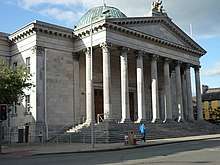
Other notable places include Elizabeth Fort, the Cork Opera House, Christ Church on South Main Street (now the Triskel Arts Centre and original site of early Hiberno-Norse church), and St Mary's Dominican Church on Popes Quay. Other popular tourist attractions include the grounds of University College Cork, through which the River Lee flows, the Women's Gaol at Sunday's Well (now a heritage centre) and the English Market. This covered market traces its origins back to 1610, and the present building dates from 1786.[53]
Parks and amenity spaces include Fitzgerald's Park to the west of the city (which contains the Cork Public Museum), the angling lake known as The Lough, Bishop Lucey Park (which is centrally located and contains a portion of the old city wall) and the Marina and Atlantic Pond (an avenue and amenity near Blackrock used by joggers, runners and rowing clubs).[54][55][56][57]
Up until April 2009, there were also two large commercial breweries in the city. The Beamish and Crawford on South Main Street closed in April 2009 and transferred production to the Murphy's brewery in Lady's Well. This brewery also produces Heineken for the Irish market. There is also the Franciscan Well brewery, which started as an independent brewery in 1998 but has since been acquired by Coors.
Local government and politics
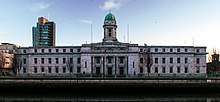
| Year | Pop. | ±% |
|---|---|---|
| 1659 | 4,826 | — |
| 1813 | 64,394 | +1234.3% |
| 1821 | 100,658 | +56.3% |
| 1831 | 107,016 | +6.3% |
| 1841 | 80,720 | −24.6% |
| 1851 | 82,625 | +2.4% |
| 1861 | 79,594 | −3.7% |
| 1871 | 78,642 | −1.2% |
| 1881 | 80,124 | +1.9% |
| 1891 | 75,345 | −6.0% |
| 1901 | 76,122 | +1.0% |
| 1911 | 76,673 | +0.7% |
| 1926 | 78,490 | +2.4% |
| 1936 | 93,322 | +18.9% |
| 1946 | 89,877 | −3.7% |
| 1951 | 112,009 | +24.6% |
| 1956 | 114,428 | +2.2% |
| 1961 | 115,689 | +1.1% |
| 1966 | 125,283 | +8.3% |
| 1971 | 134,430 | +7.3% |
| 1979 | 138,267 | +2.9% |
| 1981 | 136,344 | −1.4% |
| 1986 | 133,271 | −2.3% |
| 1991 | 127,253 | −4.5% |
| 1996 | 127,187 | −0.1% |
| 2002 | 123,062 | −3.2% |
| 2006 | 119,418 | −3.0% |
| 2011 | 119,230 | −0.2% |
| 2016 | 125,657 | +5.4% |
| 2019 | 210,000 | +67.1% |
| [58][59][60][61][62][63][64] | ||
With a population of approximately 210,000,[3] Cork is the second-most populous city in the State and the 16th-most populous area of local government.[65] Per the Local Government Act 2001, Cork City Council is a tier-1 entity of local government with the same status in law as a county council.
While local government in Ireland has limited powers in comparison with other countries, the council has responsibility for planning, roads, sanitation, libraries, street lighting, parks, and a number of other important functions. Cork City Council has 31 elected members representing six electoral areas. As of the 2019 Cork City Council election, the council's members are affiliated to the following political parties: Fianna Fáil (8 members), Fine Gael (7 members), Green Party (4 members), Sinn Féin (4 members), Labour (1 member), Solidarity–People Before Profit (1 member), Workers' Party (1 member), Independents (5 members).[66] Certain councillors are co-opted to represent the city at the South-West Regional Authority. A new Lord Mayor of Cork is chosen in a vote by the elected members of the council under a D'Hondt system count.[67][68] Since June 2020, the mayor has been Joe Kavanagh of Fine Gael.[69]
Cork City Hall is located along Albert Quay on the south side of the city. It officially opened on 8 September 1936, following the previous building being destroyed in the "Burning of Cork" in 1920. The administrative offices for Cork County Council are also located within the city limits, on the Carrigrohane Road on the west side of the city.[70]
For the purposes of elections to Dáil Éireann, the city is part of two constituencies: Cork North-Central and Cork South-Central which each returns four TDs. Following the 2016 general election, these constituencies together returned two TDs for the Fine Gael party, three for Fianna Fáil, two for Sinn Féin and one for the Anti-Austerity Alliance-People Before Profit.
In 2018, cabinet approval was given for an extension of the Cork City Council boundary, to include Cork Airport, Douglas, Ballincollig and other surrounding areas.[71][72] This extension was completed in mid-2019.[3]
Economy
Retail
The retail trade in Cork city includes a mix of modern shopping centres and family owned local shops. Shopping centres can be found in several of Cork's suburbs, including Blackpool, Ballincollig, Douglas, Ballyvolane, Wilton and at Mahon Point Shopping Centre.
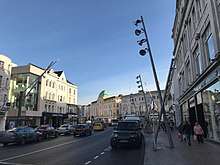
Other shopping arcades are in the city centre, including the "Cornmarket Centre" on Cornmarket Street, "Merchant's Quay Shopping Centre" on Merchant's Quay, home to Debenhams, Dunnes Stores and Marks & Spencer, and a retail street called Opera Lane off St. Patrick's Street/Academy Street. A mixed retail and office development, on the site of the former Capitol Cineplex, with approximately 60,000 square feet (5,600 m2) of retail space, was opened in June 2017.[73][74] Retail tenants in this development include Facebook, AlienVault and Huawei.[75][76]
Cork's main shopping street is St. Patrick's Street and is the most expensive street in the country per sq. metre after Dublin's Grafton Street. The area was impacted by the post-2008 downturn, though retail growth has increased since, with Penneys announcing expansion plans in 2015,[77] redesigning of some facades on the street,[78] and opening of newer outlets, including Superdry in 2015.[79] Other shopping areas in the city centre include Oliver Plunkett St. and Grand Parade. Cork is home to some of the country's leading department stores with the foundations of shops such as Dunnes Stores and the former Roches Stores being laid in the city.
Industry
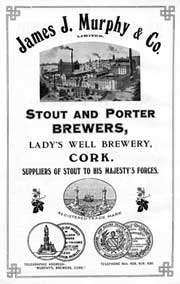
Cork City is a hub of industry in the region.[80] Several pharmaceutical companies have invested heavily in the area, including Pfizer Inc., Johnson & Johnson and Swiss company Novartis.[81] Perhaps the most famous product of the Cork pharmaceutical industry is Viagra. Cork is also the European headquarters of Apple Inc. where over 3,000 staff are involved in manufacturing, R&D and customer support.[82] Logitech and EMC Corporation are also important IT employers in the area.[83][84] Three hospitals are also among the top ten employers in the city.[85]
The city is also home to the Heineken Brewery that brews Murphy's Irish Stout and the nearby Beamish and Crawford brewery (taken over by Heineken in 2008) which have been in the city for generations. 45% of the world's Tic Tac sweets are manufactured at the city's Ferrero factory.[86] For many years, Cork was the home to Ford Motor Company, which manufactured cars in the docklands area before the plant was closed in 1984. Henry Ford's grandfather was from West Cork, which was one of the main reasons for opening up the manufacturing facility in Cork.[87] Technology has since replaced the older manufacturing businesses of the 1970s and 1980s, with people now working at a number of IT companies across the city area – such as Amazon.com, the online retailer, which has offices at Cork Airport Business Park.[88]
Cork's deep harbour allows large ships to enter, bringing trade and easy import/export of products. Cork Airport also allows easy access to continental Europe and Cork Kent railway station in the city centre provides good rail links for domestic trade.
Employment
According to the 2011 Cork City Employment & Land Use Survey, the single largest employers in the city (all with over 1,000 employees) include Cork University Hospital, Apple Inc, University College Cork, Boston Scientific, Cork City Council, Cork Institute of Technology, Bon Secours Hospital, Cork, retailers Supervalu and Centra, the Irish Defence Forces at Collins Barracks, and the Mercy University Hospital.[85]
Transport
Air
Cork Airport is the second busiest airport in the Republic of Ireland, and is situated on the south side of Cork city close to Ballygarvan. Nine airlines fly to more than 45 destinations in Europe.[89] Scheduled airlines using Cork airport include Aer Lingus, Aer Lingus Regional operated by Stobart Air, Air France, Flybe, Iberia Express, Ryanair, Swiss International Air Lines and Volotea.[90]
Bus

Public bus services within the city are provided by the national bus operator Bus Éireann. City routes are numbered from 201 through to 226 and connect the city centre to the principal suburbs, colleges, shopping centres and places of interest.[91] Two of these bus routes provide orbital services across the Northern and Southern districts of the city respectively. Buses to the outer suburbs and towns, such as Ballincollig, Glanmire, Midleton and Carrigaline are provided from the city's bus terminal at Parnell Place in the city centre. Suburban services also include shuttles to Cork Airport, and a park and ride facility in the south suburbs only.
Long-distance buses depart from the bus terminal in Parnell Place to destinations throughout Ireland. Hourly services run to Killarney/Tralee, Waterford, Athlone and Shannon Airport/Limerick/Galway and there are six services daily to Dublin. There is also a daily Eurolines bus service that connects Cork to Victoria Coach Station in London via South Wales and Bristol.
Private operators include Irish Citylink, Aircoach and Dublin Coach. Irish Citylink serves Limerick and Galway. Aircoach operates an Express non-stop service which serves Dublin City Centre and Dublin Airport 18 times daily in each direction. Dublin Coach serves Dublin via Fermoy, Mitchelstown, Cashel and Cahir.
Harbour and waterways
The Cross River Ferry, from Rushbrooke to Passage West, links the R624 to R610. This service is used by some commuters to avoid traffic in the Jack Lynch Tunnel and Dunkettle area.[92] The Port of Cork is situated at Ringaskiddy, 16 kilometres (10 miles) SE via the N28. Brittany Ferries operates direct car ferry services from Cork to Roscoff in France.[93]
Road
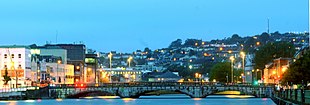
The city's road infrastructure improved in the late 20th and early 21st century, including from the early 1980s construction of the Cork South Link dual carriageway which links the Kinsale Road roundabout with the city centre. Shortly after, the first sections of the South Ring dual carriageway were opened. Work continued on extending the N25 South Ring Road through the 1990s, culminating in the opening of the Jack Lynch Tunnel under the River Lee. The Kinsale Road flyover opened in August 2006 to remove a bottleneck for traffic heading to Cork Airport or Killarney. Other projects completed at this time include the N20 Blackpool bypass and the N20 Cork to Mallow road projects. The N22 Ballincollig dual carriageway bypass, which links to the Western end of the Cork Southern Ring road was opened in September 2004. City centre road improvements include the Patrick Street project – which reconstructed the street with a pedestrian focus. The M8 motorway links Cork with Dublin.
From 2012, cycle paths and bike stands were added in a number of areas.[94] Subsequently, in 2014, a public bicycle rental scheme was launched. The scheme is operated by An Rothar Nua on behalf of the National Transport Authority, with funding supplemented by an advertising sponsor.[95] The scheme supports 330 bikes with 31 stations placed around the city for paid public use.[96]
Rail
Railway and tramway heritage
Cork was one of the most rail-oriented cities in Ireland, featuring eight stations at various times. The main route, still much the same today, is from Dublin Heuston. Originally terminating on the city's outskirts at Blackpool, the route now reaches the city centre terminus of Kent Station via the Glanmire tunnel and Kilnap Viaduct.[97] Now a through station, the line through Kent connects the towns of Cobh and Midleton east of the city. This also connected to the seaside town of Youghal, until the 1980s.[98]

Other rail routes terminating or traversing Cork city were the Cork, Blackrock and Passage Railway, a line to Macroom, the Cork and Muskerry Light Railway to Blarney, Coachford and Donoughmore, as well as the Cork, Bandon and South Coast Railway connecting Bantry, Skibbereen, Clonakilty and many other West Cork towns. West Cork trains terminated at Albert Quay, across the river from Kent Station (though an on-street rail system connected the two for rolling stock and cargo movement).
Within the city there have been two tram networks in operation. A proposal to develop a horse-drawn tram (linking the city's railway termini) was made by American George Francis Train in the 1860s, and implemented in 1872 by the Cork Tramway Company. However, the company ceased trading in 1875 after Cork Corporation refused permission to extend the line.[99]
In December 1898, the Cork Electric Tramways and Lighting Company began operating on the Blackpool–Douglas, Summerhill–Sunday's Well and Tivoli–Blackrock routes. Increased usage of cars and buses in the 1920s led to a reduction in the use of trams, which discontinued operations permanently on 30 September 1931.
The wider city area, including the city's suburbs, is served by three railway stations. These are Cork Kent railway station, Little Island railway station and Glounthaune railway station.
Current routes
Cork's Kent Station is the main railway station in the city. From here, Irish Rail services run to destinations all over Ireland. The main line from Cork to Dublin has hourly departures on the half-hour from Cork, and is linked from Limerick Junction with connections to Clonmel and Waterford. InterCity services are also available to Killarney and Tralee, and to Limerick, Ennis, Athenry and Galway (via Limerick Junction and the Limerick to Galway railway line).[100]
The Cork Suburban Rail system also departs from Kent Station and provides connections to parts of Metropolitan Cork. Stations include Little Island, Mallow, Midleton, Fota and Cobh. In July 2009 the Glounthaune to Midleton line was reopened, with new stations at Carrigtwohill and Midleton (and additional stations proposed for Blarney and elsewhere).[101] Little Island railway station serves Cork's Eastern Suburbs.
Education
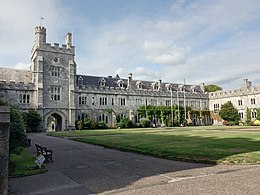
Cork is an important educational centre in Ireland – There are over 35,000 third level students in the city, meaning the city has a higher ratio of students in the population than the national average.[102] Over 10% of the population of the Metropolitan area are students in University College Cork (UCC) and Cork Institute of Technology (CIT), including nearly 3,000 international students from over 100 different countries.[103] UCC is a constituent university of the National University of Ireland and offers courses in arts, commerce, engineering, law, medicine and science. It has been named "Irish University of the Year" four times since 2003, most recently in 2016.[104] Cork Institute of Technology (CIT) was named Irish "Institute of Technology of the Year" in 2007, 2010 and 2016 and offers third level courses in Computing and IT, Business, Humanities and Engineering (Mechanical, Electronic, Electrical, and Chemical).
The National Maritime College of Ireland is located in Cork and is the only Irish college in which Nautical Studies and Marine Engineering can be undertaken. CIT incorporates the Cork School of Music and Crawford College of Art and Design as constituent schools. The Cork College of Commerce is the largest 'College of Further Education' in Ireland.[105] Other 3rd level institutions include Griffith College Cork, a private institution, and various other colleges.
Research institutes linked to the third level colleges in the city support the research and innovation capacity of the city and region. Examples include the Tyndall National Institute (ICT hardware research), IMERC (Marine Energy), Environmental Research Institute, NIMBUS (Network Embedded Systems); and CREATE (Advanced Therapeutic Engineering).[103] UCC and CIT also have start-up company incubation centres. In UCC, the IGNITE Graduate Business Innovation Centre aims to foster and support entrepreneurship.[106] In CIT, The Rubicon Centre is a business innovation hub that is home to 57 knowledge based start-up companies.[107]
Sport
Rugby, Gaelic football, hurling and association football are popular sporting pastimes for Corkonians.
Gaelic games

Hurling and football are the most popular spectator sports in the city. Hurling has a strong identity with city and county – with Cork winning 30 All-Ireland Championships. Gaelic football is also popular, and Cork has won 7 All-Ireland Senior Football Championship titles. Cork is the only county that has won both championships at least 7 times and the only that has won both in the 21st century. There are many Gaelic Athletic Association clubs in Cork City, including Blackrock National Hurling Club, St. Finbarr's, Glen Rovers, Na Piarsaigh, Nemo Rangers and Douglas GAA. The main public venues are Páirc Uí Chaoimh and Páirc Uí Rinn (named after the noted Glen Rovers player Christy Ring). Camogie (hurling for ladies) and women's Gaelic football are increasing in popularity.
Association football
Cork City F.C. are the largest and most successful association football team in Cork, winning three League of Ireland titles, four FAI Cup titles, and one "All Ireland" Setanta Sports Cup title. They play their home games on the south side of the city in Turners Cross. Several, now defunct, Cork clubs played in the League of Ireland before 1984. In total, teams from the city have won the league 12 times. Association football is also played by amateur and school clubs across the city, as well as in "five-a-side" style leagues.
Rugby
Rugby union is played at various levels, from school to senior league level. There are two first division clubs in Cork city. Cork Constitution (five-time All Ireland League Champions) play their home games in Ballintemple and Dolphin R.F.C. play at home in Musgrave Park. Other notable rugby clubs in the city include, Highfield, Sunday's Well and UCC. At schools level, Christian Brothers College and Presentation Brothers College are two of the country's better known rugby nurseries.
Munster Rugby plays a number of its home matches in the Pro14 at Musgrave Park in Ballyphehane. In the past Heineken Cup matches have also been played at Musgrave Park, but most of these are now played at Thomond Park in Limerick. In May 2006 and again in May 2008 Munster became the Heineken Cup champions, with many players hailing from Cork city and county.
Water sports
There are a variety of watersports in Cork, including rowing and sailing. There are five rowing clubs training on the river Lee, including Shandon BC, UCC RC, Pres RC, Lee RC, and Cork BC. Naomhóga Chorcaí is a rowing club whose members row traditional naomhóga on the Lee in occasional competitions. The "Ocean to City" race has been held annually since 2005, and attracts teams and boats from local and visiting clubs who row the 24 kilometres (15 mi) from Crosshaven into Cork city centre.[108] The National Rowing Center was moved to Inniscarra – approximately 12 km outside the city centre – in 2007.[109] Cork's maritime sailing heritage is maintained through its sailing clubs. The Royal Cork Yacht Club located in Crosshaven (outside the city) is the world's oldest yacht club, and "Cork Week" is a notable sailing event.[110]
Cricket
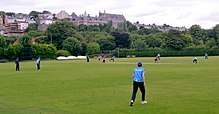
The most notable cricket club in Cork is Cork County Cricket Club, which was formed in 1874. Although located within the Munster jurisdiction, the club plays in the Leinster Senior League.[111] The club plays at the Mardyke, a ground which has hosted three first-class matches in 1947, 1961 and 1973. All three involved Ireland playing Scotland.[112] The Cork Cricket Academy operates within the city, with the stated aim of introducing the sport to schools in the city and county.[113] Cork's other main cricket club, Harlequins Cricket Club, play close to Cork Airport.[114] The provincial representative side, the Munster Reds, plays its home matches in the Twenty20 Inter-Provincial Trophy at the Mardyke Cricket Ground.
Other sports
The city contains clubs active in national competitions in basketball (Neptune and UCC Demons) and American Football (Cork Admirals). There are also golf, pitch and putt, hockey, tennis, and athletics clubs in the Cork area.
The city is the home of road bowling, which is played in the north-side and south-west suburbs. There are boxing and martial arts clubs (including Brazilian jiu-jitsu, Karate, Muay Thai and Taekwondo) within the city, while the sports-based performance art of professional wrestling maintains a presence via local promotion Phoenix Wrestling. Cork Racing, a motorsport team based in Cork,[115] has raced in the Irish Formula Ford Championship since 2005. Cork also hosts one of Ireland's most successful Australian Rules Football teams,[116] the Leeside Lions, who have won the Australian Rules Football League of Ireland Premiership several times.[116][117]
Twin cities
Cork is twinned with Cologne, Coventry, Rennes, San Francisco, Swansea and Shanghai.[118] As of February 2017, the city council was also in talks to twin with Bordeaux, Saint Petersburg and Miami.[119]
Demographics
The population of Cork City and its suburbs was recorded as 208,669 by the 2016 census,[4] with in excess of 300,000 in the Metropolitan Cork area.[120]
| Main immigrant groups, 2011[121] | |
| Nationality | Population |
|---|---|
| 6,822 | |
| 3,075 | |
| 1,126 | |
| 960 | |
| 866 | |
| 824 | |
| 640 | |
| 543 | |
| 523 | |
| 520 | |
There were 119,230 people present in the Cork City Council administered area at the time of the 2011 census, of these 117,221 indicated that they were usually present in Cork. In common with other Irish urban centres, the female population (50.67%) is higher than the male population (49.33%), although the gap is somewhat smaller than in other cities.

In the 2011 census, of those usually resident, 100,901 (86.08%) were Irish citizens; 10,295 (8.78%) were citizens of other EU countries; 4,316 (3.68%) were citizens of countries elsewhere in the world; 1,709 (1.46%) did not state their citizenship.[122] By the 2016 census, the population of the city and suburbs were 81% white Irish, 10% other white, 1.4% black/black Irish, 2.5% Asian/Asian Irish, 1.7% other, with 2.6% not stating an ethnicity.[123] Also as of the census, the population was 76.4% Catholic, 8.1% other stated religion, with 12.8% having no religion and 2.7% not stated.[123]
While Cork saw some Jewish immigration from Eastern Europe in the 19th century,[124] with second-generation immigrants like Gerald Goldberg holding public office, the community later declined and the synagogue closed.[125][126] Later immigrant communities retain their places of worship.[127][128] In the 2011 and 2016 censuses, Roman Catholicism was the most common religion in the city overall, followed by Anglicanism, Presbyterianism, and Islam.[129] As of the 2016 census, an increasing number of residents (15%) indicated that they had no religion[130] – a higher rate of increase and a higher overall percentage than the national average (10%).[131][132]
City boundary expansion
Legislation to expand the boundary of the city, which would increase its area to 187 km2 (72 sq mi) and the population within its bounds from 125,000 to 210,000,[133] was debated and approved in Dáil Éireann in June 2018.[134] Corresponding legislation was drafted during July 2018,[72] and signed into law, as part of the Local Government Act 2018, by President Michael D. Higgins in January 2019.[135] The boundary change occurred at the end of May 2019, following the 2019 local elections.[3]
Notable residents
References
- statiō bene fīdā carīnīs: literally "a good trust-station for keels", adapted by inversion from Virgil's Aeneid (II, 23: statio male fida carinis, "an unsafe harbour"). Sometimes corrupted to "fide".
- "Cork City Coat of Arms". Cork City Council. Archived from the original on 15 September 2015. Retrieved 21 February 2016.
- "Cork City's population to grow by 85,000 and expand fivefold ... at midnight". irishexaminer.com. Irish Examiner. 30 May 2019. Retrieved 31 May 2019.
- "CSO Chapter 2 – Geographical Distribution – Population by constituency" (PDF). Central Statistics Office. Retrieved 10 June 2017.
- "Cork 2050 Main Report" (PDF). corkcoco.ie. Cork County Council & Cork City Council. March 2017. Retrieved 12 November 2018.
- Patrick Weston Joyce (1923). Irish Local Names – via libraryireland.com.
- "RTÉ Television – The Harbour". RTÉ.ie. Retrieved 12 August 2010.
- "Coastal & Marine Resources Centre – Cork Harbour Marine Life Research Project Report". Cmrc.ucc.ie. Archived from the original on 29 February 2016. Retrieved 12 August 2010.
- John Paxton (2000), The Penguin encyclopedia of places (3 ed.), Penguin, ISBN 978-0-14-051275-5
- "Cork's small problem: the real issue for the real capital is its size". Irishtimes.com. 7 April 2015. Retrieved 17 November 2015.
- "The battle for Cork City, August 1922 – Interview with John Borgonovo". The Irish Story. Retrieved 22 May 2016.
- Ó Riain, Pádraig (1994). Beatha Bharra (Saint Finbarr of Cork: the Complete Life). Irish Texts Society. ISBN 1-870166-57-4.
- Moody, TW; Martin, FX; Byrne, FJ; Cosgrove, A; Ó Cróinín, D (1976). A New History of Ireland. Oxford University Press. ISBN 0-19-821737-4.
- Irish Civilization: An Introduction, Arthur Aughey and John Oakland, Routledge, 2013, p. 69
- Michael A. Monk; John Sheehan (1998). Early Medieval Munster: Archaeology, History and Society. Cork University Press. p. 172.
- "Your Council " Charters". Cork City Council. Retrieved 19 August 2012.
- "Cork City Council website – History – Walls of Cork". Corkcity.ie. Archived from the original on 23 September 2010. Retrieved 12 August 2010.
- "Charters issued to Cork city". Cork City Council. Retrieved 19 October 2010.
- "Cork City Library – History of Cork – The Burning of Cork". Corkpastandpresent.ie. 11 December 1920. Retrieved 12 August 2010.
- "Met Éireann – Annual Report 2003" (PDF). Archived from the original (PDF) on 14 June 2011. Retrieved 12 August 2010.
- Devoy, R.J.N. (2008). Coastal vulnerability and the implications of sea-level rise for Ireland (PDF) (Report). Journal of Coastal Research. pp. 327–331.
- "Met Éireann – The Irish Weather Service – 30 Year Averages – Cork Airport". Met.ie. Archived from the original on 8 August 2011. Retrieved 12 August 2010.
- "Cork 1981–2010 averages". Met Éireann. Retrieved 23 August 2019.
- "Absolute Maximum Air Temperatures for each Month at Selected Stations" (PDF). Met Éireann. Retrieved 23 August 2019.
- "Absolute Minimum Air Temperatures for each Month at Selected Stations" (PDF). Met Éireann. Retrieved 23 August 2019.
- "Cillian Murphy – Other works". IMDb.
- "Firkin Crane History". Firkin Crane. Retrieved 22 June 2016.
- "About the Graffiti Theatre Company". Graffiti.ie. Retrieved 17 October 2010.
- "Cork Film Festival Website". CorkFilmFest.org. Retrieved 12 August 2010.
- "Cork: Traditional Irish Music Venues". Trip Advisor. Retrieved 22 June 2016.
- Gilmartin, Sarah (25 September 2015), "An evening for book lovers; Irish author listed for $100,000 award; Cork stories", The Irish Times, retrieved 22 June 2016
- "Cork Opera House to reopen following major renovations". irishtimes.com. Irish Times. 18 July 2000. Retrieved 10 November 2018.
- "Cork enters 'Lonely Planet' guide as top 10 place to visit". Irish Times. 11 November 2009. Retrieved 9 February 2010.
- "Welcome to the People's Republic of Cork". People's Republic of Cork. Retrieved 19 June 2018.
- "Calls to honour much-loved Cork character Kathy Barry". echolive.ie. The Echo. 29 September 2019. Retrieved 5 March 2020.
- "Cork Midsummer Festival 2010 – Feasta Food Fair". Corkmidsummer.com. 27 June 2010. Archived from the original on 15 August 2010. Retrieved 12 August 2010.
- "Dialect Profile: The Cork Accent". Dialect Blog. 21 February 2011. Retrieved 26 March 2013.
- "Today FM and Newstalk open new studio in Cork". thejournal.ie. Journal Media. 24 January 2019. Retrieved 19 May 2019.
- "Cork Campus Radio". ucc.ie. University College Cork. Retrieved 12 August 2010.
- "Life 93.1 FM, Cork". lifefm.ie. Life FM. 2011. Retrieved 11 December 2011.
- "Cork Independent". corkindependent.com. Cork Independent. Retrieved 19 May 2019.
- "Advertise in The UCC Express". CollegeNews.ie. Retrieved 26 March 2013.
- "About". motley.ie. Motley Magazine. Retrieved 19 May 2019.
- "Medieval Cork". enfo.ie. Archived from the original on 17 May 2008.
- "Cork City Library – History of Cork – St Patrick's Street – Historic Outline". Corkpastandpresent.ie. Retrieved 12 August 2010.
- J.W. Flynn (1890). The random recollections of an old playgoer: A sketch of some old Cork theatres. Guy & Co. Retrieved 28 June 2011.
- Cork City Council. "Cork Past & Present: Cork's history, culture, places, people, and events". www.corkpastandpresent.ie. Retrieved 28 June 2011.
- "Cork County Council – About the "County Hall"". Corkcoco.ie. 12 June 1981. Archived from the original on 14 February 2008. Retrieved 12 August 2010.
- Quinn, Claire (2 September 2017). "The longest building in Ireland – the Eglinton Asylum, Cork". Architecture Ireland. Retrieved 20 November 2018.
- "Architectural Heritage Listing - Atkin's Hall, Lee Road, Cork City". National Inventory of Architectural Heritage. 1 January 2018. Retrieved 20 November 2018.
- "Church of St. Anne Shandon". Shandonbells.ie. Retrieved 12 August 2010.
- "Cork City Hall". City Mayors. Retrieved 12 August 2010.
- "English Market – Activities – Shopping – Food Markets – All Ireland – Republic of Ireland – Cork – Cork City – Discover Ireland". discoverireland.ie.
- "Marina Park Master Plan > Services > – CorkCity.ie". www.corkcity.ie. Archived from the original on 2 March 2017. Retrieved 1 March 2017.
- "Funding Approved for Marina Park and New Cork Bridge". Evening Echo. 19 January 2016. Archived from the original on 31 December 2016.
- "Revamped Fitzgerald Park opens to public but Diarmuid Gavin 'not invited'". 17 May 2014.
- www.culturefox.ie. "Grease, outdoor cinema screening at Fitzgerald Park – Culturefox". www.culturefox.ie.
- "Census 2016 Sapmap Area: Settlements County Cork City". Central Statistics Office (Ireland). Retrieved 16 November 2018.
- For 1653 and 1659 figures from Civil Survey Census of those years, Paper of Mr Hardinge to Royal Irish Academy 14 March 1865.
- "Census for post 1821 figures". Cso.ie. Archived from the original on 20 September 2010. Retrieved 12 August 2010.
- "Home". Histpop.Org. 2 April 2007. Archived from the original on 7 May 2016. Retrieved 12 August 2010.
- NISRA. "Northern Ireland Statistics and Research Agency – Census Home Page". Nisranew.nisra.gov.uk. Archived from the original on 17 February 2012. Retrieved 12 August 2010.
- Lee, JJ (1981). "On the accuracy of the Pre-famine Irish censuses". In Goldstrom, J. M.; Clarkson, L. A. (eds.). Irish Population, Economy, and Society: Essays in Honour of the Late K. H. Connell. Oxford, England: Clarendon Press.
- Mokyr, Joel; O Grada, Cormac (November 1984). "New Developments in Irish Population History, 1700–1850". The Economic History Review. 37 (4): 473–488. doi:10.1111/j.1468-0289.1984.tb00344.x. hdl:10197/1406. Archived from the original on 4 December 2012.
- Corry, Eoghan (2005). The GAA Book of Lists. Hodder Headline Ireland. pp. 186–191.
- "Cork City Council Elected Members – Elected June 2014". Cork City Council. 1 June 2014. Retrieved 28 August 2015.
- "New power-sharing deal 'opportunity to change' as Cllr Mary Shields elected". Irish Examiner Newspaper. 7 June 2014.
- "Cork city council opts for 'inclusive' d'Hondt system". Irish Times. 6 June 2014.
- "Fine Gael councillor Joe Kavanagh elected Lord Mayor of Cork". independent.ie. Independent News & Media. 12 June 2020. Retrieved 13 June 2020.
- "County Hall (Cork County Council)". Corkcoco.ie. 12 June 1981. Archived from the original on 3 March 2016. Retrieved 12 August 2010.
- "County Hall spends more than €30,000 on legal advice on boundary changes". Evening Echo. 6 June 2018.
- "Boundary increase for Cork City Council approved by Cabinet". The Irish Times. 6 June 2018.
- "Demolition under way at Capitol cinema site". Irish Examiner. 12 January 2016.
- "Excitement in Cork as €50m Capitol welcomes its first shoppers". Irish Examiner. 16 June 2017.
- "Stores in The Capitol confirmed; Oyster Tavern to reopen". Irish Examiner. 26 March 2017.
- "First business officially opened in new Capitol offices on Grand Parade Cork City by AlienVault". TheCork.ie. 11 May 2017.
- "Penneys' Big Plans For Patrick Street". Evening Echo. 26 June 2015. Archived from the original on 25 February 2017. Retrieved 24 February 2017.
- "Cork set for multi-million euro retail rebuild". Irish Examiner. 28 April 2016.
- "Superdry to open on Patrick's Street". Irish Times. 21 October 2015.
- "IDA Ireland: Era of optimism with growth evident in all sectors". irishexaminer.com. Irish Examiner. 19 October 2019. Retrieved 20 January 2020.
The South-West Region [..] grew by 5% with Cork benefiting most from increased investment
- Roche, Barry (27 July 2004). "350 new jobs for Cork under US firm's EUR700m investment". Irish Times.
Cork has seen a large concentration of [..] companies such as Pfizer, Novartis, Boston Scientific, Eli Lilly and Schering Plough, as well as Johnson & Johnson and GSK, all having significant operations in the area
- Barker, Tommy (19 July 2012). "Apple boost for city". Irish Examiner. Retrieved 29 November 2012.
- Baker, Tommy (1 November 2012). "Logitech's safe landing". Commercial Property. Irish Examiner. Retrieved 13 January 2014.
- Smith, Gordon (8 April 2011). "EMC extends its Cork research operations". The Irish Times.
- Cork City Employment & Land Use Survey 2011 (PDF) (Report). Cork City Council. March 2012. Archived from the original (PDF) on 18 December 2017.
- "Tic Tac in Ireland – Love Irish Food". Love Irish Food.
- Nyhan, Miriam (2007). Are You Still Below?: The Ford Marina Plant, Cork, 1917–84. Collins Press. ISBN 978-1-905172-49-8.
- IDA Press Release (23 April 2007). "Minister Martin officially opens Amazon in Cork". Archived from the original on 24 July 2009. Retrieved 17 May 2010.
- "Route Map". Corkairport.com. Retrieved 10 June 2017.
- "Book Flights from Cork". corkairport.com. Cork Airport daa plc. Archived from the original on 24 October 2019.
- "Cork Suburban Network Limits" (PDF). Bus Éireann. Archived from the original (PDF) on 13 April 2012. Retrieved 5 February 2012.
- Passage West Monkstown Archived 28 March 2014 at the Wayback Machine. Passagewestmonkstown.ie. Retrieved on 23 July 2013.
- "Major Cork ferry route cancelled". echolive.ie. The Echo. 29 January 2020. Retrieved 31 January 2020.
- "Cork City Cycling Strategy". Cork City Council. Retrieved 28 July 2013.
- "Galway City Council – Latest News". galwaycity.ie. Archived from the original on 12 February 2015. Retrieved 12 February 2015.
- "Cork Bike Share". Bikeshare.ie. Retrieved 10 June 2017.
- "Kilnap Viaduct". Europeana. Retrieved 24 June 2015.
- "Bring back the old Youghal railway". Evening Echo. 19 May 2018. Retrieved 24 October 2018.
- "Cork Tramway Company". askaboutireland.ie. Retrieved 24 October 2018.
- "Timetables". Irish Rail. Archived from the original on 25 August 2012. Retrieved 28 August 2012.
- "RTÉ News: Service begins on Cork-Midleton line". RTÉ.ie. 30 July 2009. Retrieved 12 August 2010.
- "Diverse and ageing Cork city faces tough challenges". Irish Examiner. 8 October 2016. Retrieved 16 December 2016.
- "Cork City Development Plan 2015–2021" (PDF). Cork City Council. 2015. Retrieved 28 July 2015.
- "Sunday Times University of the Year". Ucc.ie. 2016. Retrieved 15 May 2016.
- "About – Cork's City-Centre Campus". Cork College of Commerce. Retrieved 16 December 2016.
- "IGNITE – What we do". Ucc.ie. 2015. Retrieved 28 July 2015.
- "Rubicon Centre Overview". Ucc.ie. 2015. Archived from the original on 8 October 2015. Retrieved 28 July 2015.
- "The Race – Map of Route". Oceantocity.com. Retrieved 12 August 2010.
- RowingIreland (2 May 2007). "Press Release on National Rowing Centre opening". IARU.ie. Archived from the original on 18 November 2007.
- "Cork Week History". Corkweek.ie. 16 July 2010. Archived from the original on 1 July 2010. Retrieved 12 August 2010.
- "Cricket Leinster". www.cricketleinster.ie. Retrieved 10 June 2011.
- "First-Class Matches played on Mardyke, Cork". CricketArchive. Retrieved 10 June 2011.
- "Cork Cricket Academy – About". www.corkcricketacademy.com. Retrieved 10 June 2011.
- "Harlequins Cricket Club". Corkharlequins.com. Archived from the original on 25 July 2011. Retrieved 10 June 2011.
- "Sony teams up with Cork Racing". Irish Examiner. 13 September 2006. Retrieved 13 September 2006.
- "ARFLI Premiership – Roll of Honour". Australian Rules Football League of Ireland. Retrieved 6 April 2011.
- "Leeside Lions Website – Club Honours". LeesideLions.ie. Archived from the original on 21 July 2011. Retrieved 6 April 2011.
- "Twinned Cities". Cork City Council. Archived from the original on 30 March 2017. Retrieved 29 March 2017.
- "Cork City Council approves proposal to enter into formal relationships with Bordeaux, St. Petersburg and Miami". The Cork.ie. 14 February 2017.
- Local Electoral Area Boundary Committee Report 2013 (PDF) (Report). Government Stationery Office. 2013. Archived from the original (PDF) on 5 March 2016. Retrieved 1 October 2017.
- Census 2011 Profile 6 Migration and Diversity (PDF), p. 40, retrieved 18 October 2017
- "County Cork City (CSO Area Code CTY 17)". Central Statistics Office. Retrieved 28 September 2012.
- "Census 2016 - Small Area Population Statistics (SAPMAP Area) - Settlements - Cork City & Suburbs". Census 2016. Central Statistics Office.
- "Cork's Jewish community commemorated in new exhibition". Irish Times. 5 June 2017.
- "Fall-off in number of Jews forces only Cork synagogue to shut". Irish Times. 8 February 2016.
- "History of the Cork Hebrew Congregation and the Jews of Cork". Corkhebrewcongregation.com. Archived from the original on 11 March 2010.
- "Immigration/ New Irish". Diocese of Cork and Ross. Retrieved 7 June 2017.
- "Cork Muslim community seeks replacement imam". Irish Examiner. 23 April 2014.
- "Area Profile – Cork City" (PDF). Census 2011 Results. Central Statistics Office. Retrieved 7 June 2017.
- "Census 2016: Population of Cork rises 4.6%". Irish Examiner. 7 April 2017.
- "Census 2016: Population growth slowest in 20 years". RTÉ. 6 April 2017.
- "Cork's population has become less religious and older". Evening Echo. 7 April 2017.
- "Cork City Council Boundary Extension 2019". corkcity.ie. Cork City Council. Retrieved 29 January 2019.
- "Bill set to give effect to Cork boundary extension". irishexaminer.com. Irish Examiner. 31 July 2018. Retrieved 26 August 2018.
- "Cork city boundary extension set for June". rte.ie. RTÉ News. 25 January 2019. Retrieved 29 January 2019.
Further reading
- Merchants, Mystics and Philanthropists – 350 Years of Cork Quakers Richard S. Harrison Published by Cork Monthly Meeting, Religious Society of Friends (Quakers) 2006 ISBN 978-0-9539542-1-6
- Atlas of Cork City, edited John Crowley, Robert Devoy, Denis Linehan and Patrick O'Flanagan. Illustrated by Michael Murphy. Cork University Press, 2005, ISBN 1-85918-380-8.
- A New History of Cork, Henry A. Jefferies. History Press Ireland, 2010, ISBN 978-1-84588-984-5.
- Cork Rock: From Rory Gallagher To The Sultans Of Ping, by Mark McAvoy. Published by Mercier Press (2009) ISBN 978-1-85635-655-8.
- Where Bridges Stand :the River Lee bridges of Cork City, Antóin O'Callaghan. History Press Ireland, 2012, ISBN 978-1-84588-746-9.
- Cork City Through Time, Kieran McCarthy & Daniel Breen. Stroud : Amberley, 2012, ISBN 978-1-4456-1142-6.
External links
| Wikimedia Commons has media related to: |
| Wikisource has the text of an 1879 American Cyclopædia article about Cork. |
| Wikivoyage has a travel guide for Cork. |
- Cork City Council site
- Architecture of Cork
- . Encyclopædia Britannica. 7 (11th ed.). 1911. pp. 158–160.
